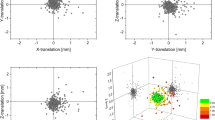Purpose:
To investigate the magnitude and clinical relevance of relative motion/nonrigid setup errors in the head-and-neck (H&N) region.
Material and Methods:
Eleven patients with tumors in the H&N region were immobilized in thermoplastic head masks. Patient positioning was verified using a kilovoltage cone-beam CT (kv CBCT) prior to 100 treatment fractions. Five different regions of interest (ROIs) were selected for automatic image registration of planning CT and verification CBCT: (1) the whole volume covering planning CT and CBCT, (2) the skull, (3) the mandible, (4) C1–C3, and (5) C4–C6. Differences were calculated describing relative motion between the ROIs.
Results:
The 3-D patient setup error was 3.2 mm ± 1.7 mm based on registration of the whole volume. No systematic relative motion (group mean errors < 0.5 mm and < 0.5°) between planning and treatment for any ROI was observed. Mobility was largest for the skull and the mandible relative to C4–C6 with 3-D displacements of 4.7 mm ± 2.5 mm and 4.4 mm ± 2.5 mm. Relative rotations were largest around the left-right axis (nodding) between C1–C3 and C4–C6 with maximum 11°. No time trend of relative motion was observed. Margins for compensation of relative motion ranged between 5 mm and 10 mm.
Conclusion:
The simplification of the patient as a rigid body was shown to result in significant errors due to relative motion in the H&N region. Margins for compensation of relative motion exceeded margins for compensation of patient positioning errors.
Ziel:
Untersucht wurden das Ausmaß und die klinische Relevanz nichtrigider Lagerungsfehler bei der Behandlung von Kopf-Hals-Tumoren.
Material und Methodik:
Elf Patienten waren für die Strahlenbehandlung von Kopf-Hals-Tumoren mittels thermoplastischer Masken immobilisiert. Bei 100 Fraktionen wurde die Patientenpositionierung mittels eines Kilovolt-Cone-Beam-CT (kv-CBCT) kontrolliert. Die automatische Registrierung von Planungs-CT und Verifikations-CBCT basierte auf fünf verschiedenen Regionen: 1. dem gesamten Volumen von Planungs-CT und Verifikations-CBCT, 2. Schädel, 3. Unterkiefer, 4. C1–C3 und 5. C4–C6. Die Unterschiede zwischen den Registrierungen beschrieben das Ausmaß der Relativbewegungen im Kopf-Hals-Bereich.
Ergebnisse:
Der dreidimensionale Lagerungsfehler, basierend auf Region 1 (gesamtes Volumen), betrug 3,2 mm ± 1,7 mm. Für keine der anatomischen Regionen wurde eine systematische Relativbewegung zwischen Planung und Behandlung festgestellt (< 0,5 mm und < 0,5°). Am größten war die Beweglichkeit des Schädels und des Unterkiefers relativ zur kaudalen Halswirbelsäule: 4,7 mm ± 2,5 mm und 4,4 mm ± 2,5 mm. Rotationsbewegungen waren zwischen kranialer und kaudaler Halswirbelsäule am größten: maximal 11° um die Links-rechts-Achse (Nickbewegung). Ein zeitlicher Trend der Relativbewegungen wurde nicht beobachtet. Sicherheitssäume von 5–10 mm waren zur Kompensation dieser Relativbewegungen notwendig.
Schlussfolgerung:
Substantielle Relativbewegungen im Kopf-Hals-Bereich widerlegen ein rigides Patientenmodell. Sicherheitssäume von 5–10 mm zur Kompensation dieser Relativbewegungen verdeutlichen die klinische Relevanz.
Similar content being viewed by others
Author information
Authors and Affiliations
Corresponding author
Rights and permissions
About this article
Cite this article
Polat, B., Wilbert, J., Baier, K. et al. Nonrigid Patient Setup Errors in the Head-and-Neck Region. Strahlenther Onkol 183, 506–511 (2007). https://doi.org/10.1007/s00066-007-1747-5
Received:
Accepted:
Issue Date:
DOI: https://doi.org/10.1007/s00066-007-1747-5




